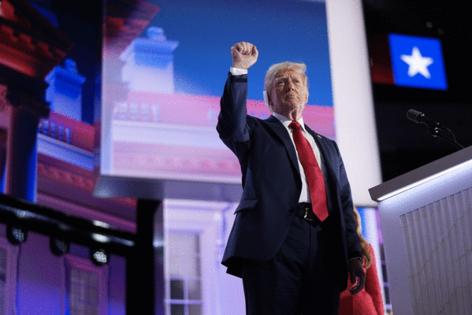Commentary: Donald Trump's visual politics are reshaping America
Published in Op Eds
As calls mounted for President Joe Biden to withdraw from the 2024 race following his dreadful debate performance, Democrats grappled with a stark reality: Their efforts to counter former President Donald Trump’s visual political style were falling woefully short.
This challenge should have surprised no one. Following the 2016 presidential election, Politico published a fascinating post about Chuck Todd’s experiences interviewing Trump.
Put simply, Todd told us, Trump likes to watch. He likes to watch others and he likes to watch himself. “He’s a very visual guy,” Todd said. “He thinks this way, and look, it’s an important insight in just understanding him.”
Trump’s instinct to watch himself specifically registered with Todd. “Then there’s the amount of time he spends after the interview is over, with the sound off. He wants to see what it all looked like. He will watch the whole thing on mute.”
Todd’s insights capture a truth about contemporary politics that extends well beyond Trump to the structural foundations of our political imagination. The instinct and internal mandate to watch himself gives us definitive evidence of Trump’s ancient regime solipsism and narcissism. But most of us already knew that.
The key to the 2016 election’s outcome was really how Trump transacted a relationship based on emotionally resonant symbols. This symbolic language liberated Trump supporters to bypass the conventional neural pathways of Beltway politics and directly mainline the emotional euphoria of visual “truths” — that which is immediately in our field of vision.
If we connect these insights about the effectiveness of Trump’s communication style to the visual way in which he experiences the world, his political existence starts to make sense.
Consider the physicality of the Trump worldview, its primitive and extractive materialism, associated with monoliths such as his towers, his mansions, his golf courses, his casinos and his Mexican wall. Each of these physical structures represent a visual tally of his wealth and his worth.
Trump’s material focus, because it is extractive and zero-sum, also intensifies sensations of threat and scarcity, the idea that anything solid can be taken from one and will be if one does not defend and protect it. At this threat intersection, the visual images summoned by Trump fully come into play, as avatars of a primal set of truths and facts that run more deeply than logic or data.
During the 2016 campaign, as Todd observed, Hillary Clinton went 1990s old-school with her briefing books — assuming facts, policies, interests and logic were all that mattered and all anyone cared about. At the same time, Trump was connecting directly — via Twitter and via his campaign events — with tens of millions of Americans. For these supporters, facts, policies, interests and logic — considered as the material of “truth” and “reality” — were elusive and dangerous
As we observe the 2024 presidential campaign unfold, the power of Trump’s visual politics continues to shape the political landscape. Consider the following developments in the past 12 months alone.
Mug shot phenomenon: Trump’s booking photo became an instant cultural touchstone, transformed into a powerful symbol of defiance.
Courtroom as stage: Trump’s courtroom appearances have become political theater, each a visual performance crafted to communicate strength, victimhood or righteous anger.
Rally aesthetics: Trump’s campaign rallies continue to be exercises in visual branding, creating visceral, emotional connections with his base.
Social media evolution: Trump has adapted his visual communication style to new formats, favoring short, punchy video clips and memes.
Assassination attempt: Following the attempt on Trump’s life, the visual narrative shifted to images of him as a quasi-martyr, reinforcing the idea of his presidency as divinely ordained.
Democratic Party politics are and always have been about concrete goals and some measurable concept of progress. As Trump and his cohorts might say: Boring.
For Trump (and now the entire Republican Party), politics are pretty much exclusively about maintaining the darkly exuberant feeling one might associate with methamphetamine.
Ask supporters of Trump and the Republican Party to specify the world they would like to create. Few could provide a coherent answer, and few would care that they couldn’t.
There is no way to reconcile these conceptions of politics.
In the head-to-head matchup with Kamala Harris, Trump retains significant advantages. He remains a formidable opponent with a united Republican Party behind him. Structural factors such as the electoral college imbalance and economic perceptions continue to favor the GOP.
The Democratic Party certainly needs to develop a visual language that can compete with Trump’s emotional resonance, while still maintaining a commitment to factual accuracy and policy substance. Part of the challenge, however, is that all of us are complicit in succumbing to the never-ending Trump train wreck.
Mainstream liberal media feasts on it. New York Times and Washington Post web traffic were never stronger than during the Trump administration. As one prominent D.C. literary agent joked, “Donald Trump is paying for my retirement.” Everyone’s rubbernecking to take in the carnage. No one has their eyes on the road.
The Harris-Walz love fest at the recently wrapped Democratic National Convention in Chicago both challenges and confirms these contradictions. As we navigate the 2024 election cycle, an existential dilemma stalks American democracy. How can we reconcile the power of visual, emotionally charged political communication with the need for substantive policy discussion and rational decision-making?
The rise of visual politics in the age of Trump is not a temporary phenomenon. It is a fundamental shift in how political messages are conveyed and received. As we move through the 2024 campaign and beyond, our ability to understand, adapt to and engage this new reality will determine the future of American democracy.
____
Peter H. Schwartz writes at the broad intersection of philosophy, politics, history and religion. He publishes the Wikidworld newsletter on Substack.
___
©2024 Chicago Tribune. Visit at chicagotribune.com. Distributed by Tribune Content Agency, LLC.




























































Comments